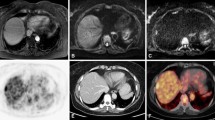Abstract
Purpose
We compared the detectability of liver metastases on 2- and 3-phase images using robust statistical methods. Nine radiologists evaluated unenhanced CT plus portal venous phase (2-phase) images and 2-phase plus hepatic arterial phase (HAP) (3-phase) images.
Materials and methods
Our study included 54 patients with primary malignant tumors who underwent 3-phase hepatic dynamic CT more than twice to screen for liver metastases; 24 had 1–6 liver metastases measuring 4–27 mm in diameter (median 13 mm). The other 30 had no metastases. Nine board-certified radiologists participated in our observer performance study. They specified the location of the metastatic lesions and rated the probability of metastatic nodules on 2-phase images acquired with and without HAP imaging. We used jackknife alternative free-response receiver operating characteristic (JAFROC) analysis to compare their performances.
Results
For all radiologists the area under the curve without and with HAP imaging was 0.86 and 0.88, respectively; the difference was significant (p = 0.04). For metastases smaller than 10 mm the averaged lesion localization fraction without and with HAP imaging was 0.17 and 0.26 (p < 0.01).
Conclusion
Adding HAP to 2-phase imaging improved the detectability of liver metastases, especially of lesions smaller than 10 mm.




Similar content being viewed by others
References
Pawlik TM, Schulick RD, Choti MA. Expanding criteria for resectability of colorectal liver metastases. Oncologist. 2008;13:51–64.
Bonaldi VM, Bret PM, Reinhold C, et al. Helical CT of the liver: value of an early hepatic arterial phase. Radiology. 1995;197:357–63.
Gabata T, Matsui O, Terayama N, et al. Imaging diagnosis of hepatic metastases of pancreatic carcinomas: significance of transient wedge-shaped contrast enhancement mimicking arterioportal shunt. Abdom Imaging. 2008;33:437–43.
Hollett MD, Jeffrey RB Jr, Nino-Murcia M, et al. Dual-phase helical CT of the liver: value of arterial phase scans in the detection of small (≤1.5 cm) malignant hepatic neoplasms. AJR Am J Roentgenol. 1995;164:879–84.
Paulson EK, McDermott VG, Keogan MT, et al. Carcinoid metastases to the liver: role of triple-phase helical CT. Radiology. 1998;206:143–50.
Scott DJ, Guthrie JA, Arnold P, et al. Dual phase helical CT versus portal venous phase CT for the detection of colorectal liver metastases: correlation with intra-operative sonography, surgical and pathological findings. Clin Radiol. 2001;56:235–42.
Sheafor DH, Frederick MG, Paulson EK, et al. Comparison of unenhanced, hepatic arterial-dominant, and portal venous-dominant phase helical CT for the detection of liver metastases in women with breast carcinoma. AJR Am J Roentgenol. 1999;172:961–8.
van Leeuwen MS, Noordzij J, Feldberg MA, et al. Focal liver lesions: characterization with triphasic spiral CT. Radiology. 1996;201:327–36.
Raptopoulos VD, Blake SP, Weisinger K, et al. Multiphase contrast-enhanced helical CT of liver metastases from renal cell carcinoma. Eur Radiol. 2001;11:2504–9.
Miller FH, Butler RS, Hoff FL, et al. Using triphasic helical CT to detect focal hepatic lesions in patients with neoplasms. AJR Am J Roentgenol. 1998;171:643–9.
Chakraborty DP. New developments in observer performance methodology in medical imaging. Semin Nucl Med. 2011;41:401–18.
Hillis SL, Berbaum KS, Metz CE. Recent developments in the Dorfman-Berbaum-Metz procedure for multireader ROC study analysis. Acad Radiol. 2008;15:647–61.
Kobayashi T, Xu XW, MacMahon H, et al. Effect of a computer-aided diagnosis scheme on radiologistsʼ performance in detection of lung nodules on radiographs. Radiology. 1996;199:843–8.
Dorfman DD, Berbaum KS, Metz CE. Receiver operating characteristic rating analysis. Generalization to the population of readers and patients with the jackknife method. Invest Radiol. 1992;27:723–31.
Frederick MG, Paulson EK, Nelson RC. Helical CT for detecting focal liver lesions in patients with breast carcinoma: comparison of noncontrast phase, hepatic arterial phase, and portal venous phase. J Comput Assist Tomogr. 1997;21:229–35.
Chakraborty DP, Winter LH. Free-response methodology: alternate analysis and a new observer-performance experiment. Radiology. 1990;174:873–81.
Niekel MC, Bipat S, Stoker J. Diagnostic imaging of colorectal liver metastases with CT, MR imaging, FDG PET, and/or FDG PET/CT: a meta-analysis of prospective studies including patients who have not previously undergone treatment. Radiology. 2010;257:674–84.
Chen L, Zhang J, Zhang L, et al. Meta-analysis of gadoxetic acid disodium (Gd-EOB-DTPA)-enhanced magnetic resonance imaging for the detection of liver metastases. PLoS ONE. 2012;7:e48681.
Merkle EMFT, Boll DT, Brambs H. Hepatic mass lesions. In: Haage JRLC, Gilkeson RC, editors. CT and MR imaging of the whole body. St. Luis: Mosby; 2003. p. 1297.
Schwartz D. Secondary lung tumors. In: Medscape drugs, diseases and procedures; 2012. http://emedicine.medscape.com/article/426820-overview.
Wiering B, Krabbe PF, Jager GJ, et al. The impact of fluor-18-deoxyglucose-positron emission tomography in the management of colorectal liver metastases. Cancer. 2005;104:2658–70.
Bipat S, van Leeuwen MS, Comans EF, et al. Colorectal liver metastases: CT, MR imaging, and PET for diagnosis: meta-analysis. Radiology. 2005;237:123–31.
Kinkel K, Lu Y, Both M, et al. Detection of hepatic metastases from cancers of the gastrointestinal tract by using noninvasive imaging methods (US, CT, MR imaging, PET): a meta-analysis. Radiology. 2002;224:748–56.
D’Souza MM, Sharma R, Mondal A, et al. Prospective evaluation of CECT and 18F-FDG-PET/CT in detection of hepatic metastases. Nucl Med Commun. 2009;30:117–25.
Lubezky N, Metser U, Geva R, et al. The role and limitations of 18-fluoro-2-deoxy-d-glucose positron emission tomography (FDG-PET) scan and computerized tomography (CT) in restaging patients with hepatic colorectal metastases following neoadjuvant chemotherapy: comparison with operative and pathological findings. J Gastrointest Surg. 2007;11:472–8.
Brenner DJ, Elliston CD. Estimated radiation risks potentially associated with full-body CT screening. Radiology. 2004;232:735–8.
Van den Eynde M, Hendlisz A. Treatment of colorectal liver metastases: a review. Rev Recent Clin Trials. 2009;4:56–62.
Choi BI, Lee KH, Han JK, et al. Hepatic arterioportal shunts: dynamic CT and MR features. Korean J Radiol. 2002;3:1–15.
Conflict of interest
This study was performed using a research grant provided to the Department of Diagnostic Radiology, Hiroshima University (Chair: Kazuo Awai) by Bayer Yakuhin Co. Ltd. (Osaka, Japan). The other authors declare that they have no conflict of interest.
Author information
Authors and Affiliations
Corresponding author
About this article
Cite this article
Honda, Y., Higaki, T., Higashihori, H. et al. Re-evaluation of detectability of liver metastases by contrast-enhanced CT: added value of hepatic arterial phase imaging. Jpn J Radiol 32, 467–475 (2014). https://doi.org/10.1007/s11604-014-0331-z
Received:
Accepted:
Published:
Issue Date:
DOI: https://doi.org/10.1007/s11604-014-0331-z




